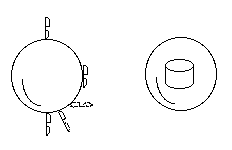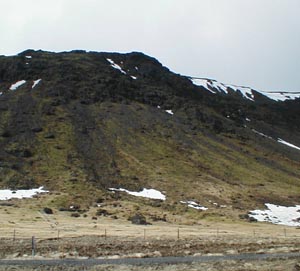This can be fun, if you have the inclination.

Staples cling to a sphere with a strong magnet at its
center.
This can be fun, if you have the inclination.

Staples cling to a sphere with a strong magnet at its
center.
Introduction
With this activity you can make a 3 dimensional model of the magnetic fields of planets by inserting a small yet strong magnet into a sphere. Then you can show the magnetic field by sprinkling used staples onto the sphere. The orientation of the staples changes with latitude.
Materials
Assembly
If you're assembling your own magnetic earth, cut
a slit in the SqueeshballTM, and
insert the magnet into the center. Point one of the flat ends of the
magnet toward the north pole of the earth. Reseal the ball with
silicone seal or hot melt glue.
Try This!
Explore the magnetic field of the ball. If you place a used staple on the ball, the staple will stick to the ball and line up with the ball's magnetic field. Add more staples to the ball. Notice that the staples lie flat against the ball along a circle, this is the "magnetic equator. " At the "magnetic poles," the staples stand up vertically. Between the poles and the equator the staples stand up at different angles with respect to a plane tangent to the ball. The angle between the staple and the tangent plane is known as the "magnetic inclination" or the "dip of the magnetic field."
The Magnaprobe (optional) is a compass that is free to rotate in three dimensions. Use it or a compass to explore the magnetic field surrounding the sphere. The field stretches away from the sphere; in the same way, the earth’s magnetic field stretches far out into space. The earth’s field traps charged particles from the sun making the Van Allen radiation belts.
If the compass or magnaprobe is held far from the magnetic sphere it will align itself with the magnetic field of the real earth rather than your earth model. Notice that in North America the north pole of the magnaprobe (red) points north and down.
What’s Going On?
The earth is a magnet with magnetic north and south poles. Because it has only two poles, two places where the staples stand up vertically, its magnetic field is modeled by what is called a "dipole field."
A sphere with a magnet inside creates a magnetic
dipole like that of the earth. The staples will line up with this
magnetic field. As the staples align, they show field lines that run
between the north and south poles, they also show that the field over
most of the sphere is not tangent to its surface.
Although the magnetic field of this experiment is created by a
permanent magnet, the earth is actually an electromagnet. The earth's
magnetic field is created by electric currents which flow in the
rotating and convecting liquid metal of the earth’s outer
core.
A compass lines up with the earth’s magnetic field, however, the pivot of the compass does not allow it to rotate up or down so it only shows the horizontal component of the field.
Etc.
The magnetic poles move
Explorers who search for the place where a compass aligns itself
straight up-and-down find the magnetic poles of the earth. One
magnetic pole is currently in Canada more than 15 degrees of latitude
from the geographic North Pole. Because of the way magnetic poles
were originally named that pole is actually a magnetic south pole.
Today, the other magnetic pole is off the coast of Antarctica. In
1913 the Australian Antarctic Expedition commanded by Douglas Mawson
found the Antarctic magnetic pole on land. The magnetic poles of the
earth move with time.
Etc.
The magnetic poles reverse.
Besides moving around, the poles of the earth occasionally reverse.
The last major reversal was 780,000 years ago; the previous one was
1.1 million years before that. So if we are patient enough the poles
of the earth will flip and the magnetic north pole will actually be
near the north geographic pole. The flips take less than a thousand
years and during a flip the strength of the earth's field decreases
to 10% or so of its maximum value.

Etc.
The naming of the magnetic poles
When needles of magnetite were found to point toward the north pole
star no one knew that the needles were magnets or that the earth
itself was a magnet so the end that pointed toward the north pole was
called the "north seeking pole." Today that name has been shortened
to the "north pole" of the magnet. Since opposite magnetic poles
attract, when the earth itself was discovered to be a magnet , this
naming convention meant that the pole of the earth's magnet nearest
the geographic North Pole had to be a magnetic south pole. This has
led to hundreds of years of confusion. Only a future flip of the
magnetic poles of the earth can save us from our current
state.
|
Scientific Explorations with Paul Doherty |
|
7 January 2008 |